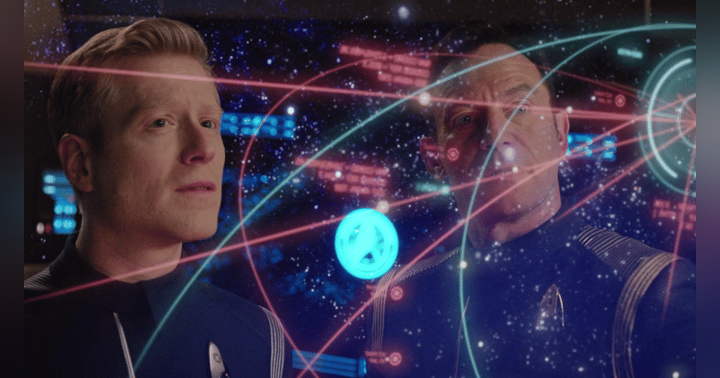The Important Job of Hope

Have you ever gone camping? Not like tent and sleeping bag camping. More like dumped in the middle of the woods with nothing but the clothes on your back kind of camping. Probably not. But have you ever been in a work situation that felt a little like that? Stranded without support on a project with a looming deadline. Or left all alone to deal with a chaotic customer situation? That’s what happened to the Voyager crew in “Basics Parts 1 and 2.” Amid this tense and difficult Season 2 finale and Season 3 premiere, Captain Janeway shines. She teaches her crew just how important hope is when everything seems dark, something we can apply to our workplace leadership as well.
Here’s the thousand-foot view of these two episodes. Seska, a Maquis who left Voyager to join the Kazon, sends a message asking for help. She believes she and her baby are in danger and requests a rescue. Janeway knows immediately that her request is a trap. So the leaders devise a plan to approach the Kazon cautiously. Unfortunately, the trap they were prepared for was stronger than they expected. After a valiant fight, Voyager is overtaken by the Kazon and the crew is abandoned, without any technology or supplies, on an unknown planet. Left to die, they have no choice but to figure out how to survive. In three, clear directives, Janeway makes her priorities known:
“Make it clear to everyone that we expect to be rescued.”
“It’s very important this crew be given a sense of hope.”
“That’s our most important job right now.”
If I’m a part of the Voyager crew I’m probably going to be really upset about the circumstances I find myself in. Not only am I on the other side of the galaxy, but now there is zero chance I’ll ever get home. I’m alone, I’m cold, and I’m hungry. Oh, and that CGI monster over there? Totally going to eat me. Despair is looking like a logical choice right about now. Can you think of a time when you have felt similarly at work? Do you know if your team has ever been in this place?
Janeway says that offering hope is their top priority. Well, guess what. If you’re in a leadership position, the same goes for you! Polly Campbell wrote a great article for Psychology Today in 2019 called “Why Hope Matters.” In it, she writes that hope shows the possibility of something better and that it helps to keep us going. She references the work of researcher C.R. Snyder who says that hope implies that there is the possibility of a better future. Now, what do you think that kind of hope means to a server drowning in the dinner rush or a salesperson walking away from the fourth door that's been slammed in their face? Hope means everything to them.
But where does hope come from? I think hope can come from a lot of places. Our hearts, our spirits, our imaginations. But often, hope is formed by the leaders in our lives. Faith leaders, political leaders, leaders in the media, and our workplace. We listen as they share their thoughts and vision. Often, even their reactions or general statements about a situation can influence our hope. If you are a leader, you hold the power to push someone toward hope or despair.
In March of 2020, when the world began responding to COVID-19, my job changed, as did many others. Regardless of where you land on the political spectrum of COVID, we can all agree that the world looked very bleak, right? But we had to keep working and living. That was hard to do when every other tweet had more bad news. The news was there to create stress. So guess what became my most important job? Hope. It’s almost like Janeway was in my ear guiding me along. I thought of myself, and the leaders I worked with, as hope dealers. When things aren’t good, leaders need to create that vision of hope and a better future. Please don’t hear me say that leaders should lie, or make light of situations. I’m saying just the opposite. Leaders must be painfully honest. We saw this with Janeway. She didn’t gloss over any of the hardships. But she knew how to lead her people toward hope.
First, she was quick to make an objective assessment of the situation. They’re stranded with nothing more than the jumpsuits on their backs, but she knows there is a chance of rescue. Second, she relied on her survival training from the Academy and in Starfleet to know the tasks that needed to be done. She identified work and asked everyone to help, which met needs and gave people purpose. Finally, she spoke with the leaders and gave them crystal clear instructions to create hope for people. This is a model you can follow too. It’s not hard, but it does require that you have both a realistic and an optimistic viewpoint. Some people are pragmatically optimistic, like Janeway, focusing on the reality of the situation in front of them but also being optimistic about the outcomes. Other people are optimistically pragmatic, like me! I start with the belief that everything will be ok and then I pepper reality in here and there. Either approach is fine, but both aspects are needed.
When you find yourself in a difficult situation – hopefully not as bad as being stranded on a planet – you can step up your leadership game by following this model. Make an objective assessment of the situation. What’s important here is to not allow emotion to influence you. Don’t panic or start letting your mind run down rabbit holes. Simply observe and assess what is happening. Then determine what needs to be done. Are there critical needs? Take care of those things immediately. But then, identify meaningful tasks that the people around you can start doing. When you’re left to just exist or do something that is clearly useless, that’s when your mind starts to go through worst-case scenarios. Give people purpose and value-added tasks that will help with the situation. In a crisis, people need purpose.
Finally, work with your leaders to develop a shared message. You can’t be advocating for positive thinking while another leader on your team is buying into negativity. Think of the people you work with as existing on a continuum. Based on concepts like the Pareto Principle and Standard Bell Curve Distribution, people will tend to fall into a 10, 80, 10 distribution. What that means is that in a crisis 10% of the people will be panicking and playing out doomsday scenarios in their heads, 10% will be looking at the bright side of life, and 80% are going to go whichever way the wind blows. If you and your leaders focus on the naysayers, the 80% will skew that way. But, and here’s the real power in being a hope dealer, if you focus on the good things, if you build and communicate hope, the 80% will skew that way too. Which would you rather have? 90% of the people around you believing the ship’s going to sink or 90% believing lifeboats are on their way?
Hope is not just a nice idea found on home decor signs. Or even a made-up platitude with no tangible impact. It’s a powerful tool in life and work. The next time you find your team, or the world, in a crisis, remember your training: objectively assess, determine the needs, and develop a shared message. You can be the hope dealer in your company. You’ll keep people motivated and positive, as you lead them through the crisis with hope.


